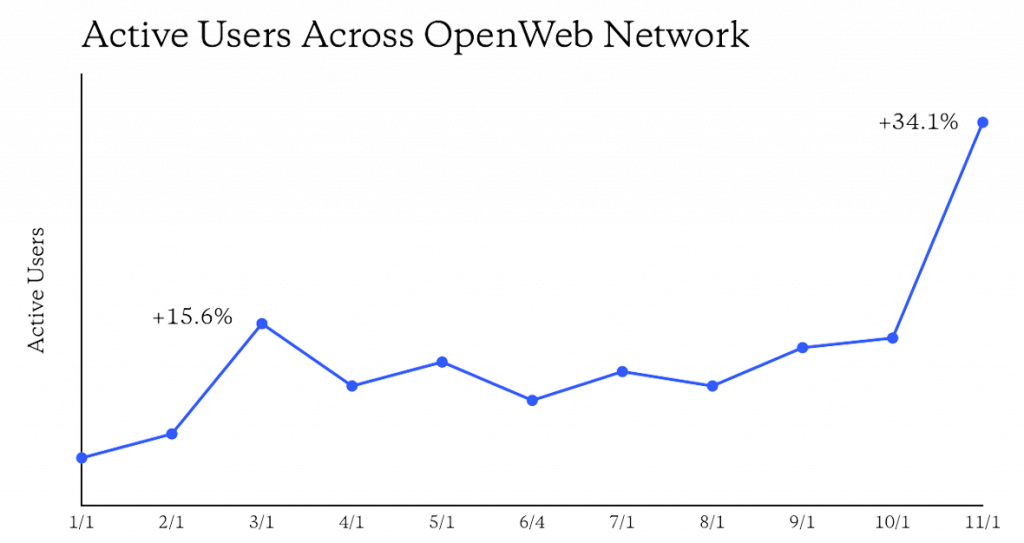We at OpenWeb work with more than 1,000 publishers to build thriving, independent communities and create healthy, high-quality conversations. That scale gives us access to a unique bird’s eye view of the user behavior of more than 100 million monthly active users across the open web.
Throughout 2020’s many ups and downs, one thing was constant: as news broke, readers turned to the comment section to understand, connect, express, and share in the public reaction.
This increase in activity is really significant for the publishing business: active users spend more time on site, and they are more likely to return than casual readers. And as the quality of conversations rises across our network, so does the portion of users engaging in comments.
Below we’ll take a look at some of the key trends from the communities across our network in 2020and how to increase active users on your site. Our observations are based on our proprietary data from 100 million monthly active users.
Findings snapshot:
- As news of COVID-19 broke, there was a 15.6% increase in people spending time in the conversation. The “replies to comments ratio” – an indicator of how dynamic and engaging the conversation was – was highest during this time with 1.5 replies to every comment.
- During the peak of the Summer’s Black Lives Matter protests, we saw a 75% increase in people who engaged by reading comments.
- And, another major historical moment, the US election sparked the highest lift in activity with a 34.1% increase in people spending time in the conversation.


COVID-19 sparked ongoing conversations in 2020
- As life for many moved online in March 2020, we saw a surge in active users across our network. The number of people who read, like/disliked, replied, or commented on an article jumped by 15.6% from February to March, showing that more people were spending time in online conversations after news broke about COVID-19.
- March also was a time when people wanted more connection. We saw increases in users clicking on the “show more comments” button to expand the comments section (22.3%) and the “show more replies” button (23.7%). It’s clear that user-generated content played a big role in the way people interacted with articles about COVID-19.
- In April, we saw a 12.5% increase in replies. The replies to comments ratio was at its highest during this time, with an average of 1.5 replies to every comment. This means that more and more users across the open web were compelled to weigh in and contribute to deeper discussions and shows us how to increase active users regarding the ongoing issues.

As Black Lives Matter protests surged in the summer, more people listened
- After George Floyd was killed in May, sparking nationwide protests in June, we saw a massive increase (75%) in observers (users who chose to read others’ comments without otherwise participating in the conversation).
- Following the increase of observers, we noted a 8.7% increase in people who clicked “show more comments” in July. There is no doubt that users were interested in the views of others, and—thanks to our moderation technology—open forums for discussion undoubtedly played a big role in helping groups understand one another during an intense moment in history.

During the election and a second wave of COVID-19, engagement skyrocketed
- If the Black Lives Matter movement of the summer brought about a time to listen and learn, the election and COVID-19 wave of the Fall was a time of unprecedented, lively debate. In September—right after Kamala Harris was announced as Joe Biden’s running mate, and COVID was in the news again—we saw a 12.5% increase in commenters.
- Engagement levels surpassed the peak associated with March’s initial nationwide lockdowns, with a 34.1% increase in readers who were actively engaged during the month of November.
- On Election Day, we saw a 20.3% increase in users spending time in conversation. As results unfolded, states were announced or contested, users kept looking to the comments to share and read opinions and predictions, and look for updates. Read more about our election insights here.
So, where are conversations headed in 2021?
In 2020, online communities played a vital role in helping people connect with each other amidst a tumultuous time. Across our partner communities, the amount of time users spent in the comments section soared: people were eager to join conversations, read others’ thoughts, and gain new perspectives. In a year filled with uncertainty, it was important to find ways to make meaningful connections—and online communities gave people the opportunity to do just that.
In 2021, this will continue, but only if users are empowered to have healthy, productive, high-quality conversations.
Publishers have an opportunity to create environments where quality can flourish, improving user experience so that they keep coming back. We don’t know about you, but we can’t wait.
Learn more about how publishers can create healthy online communities with OpenWeb


